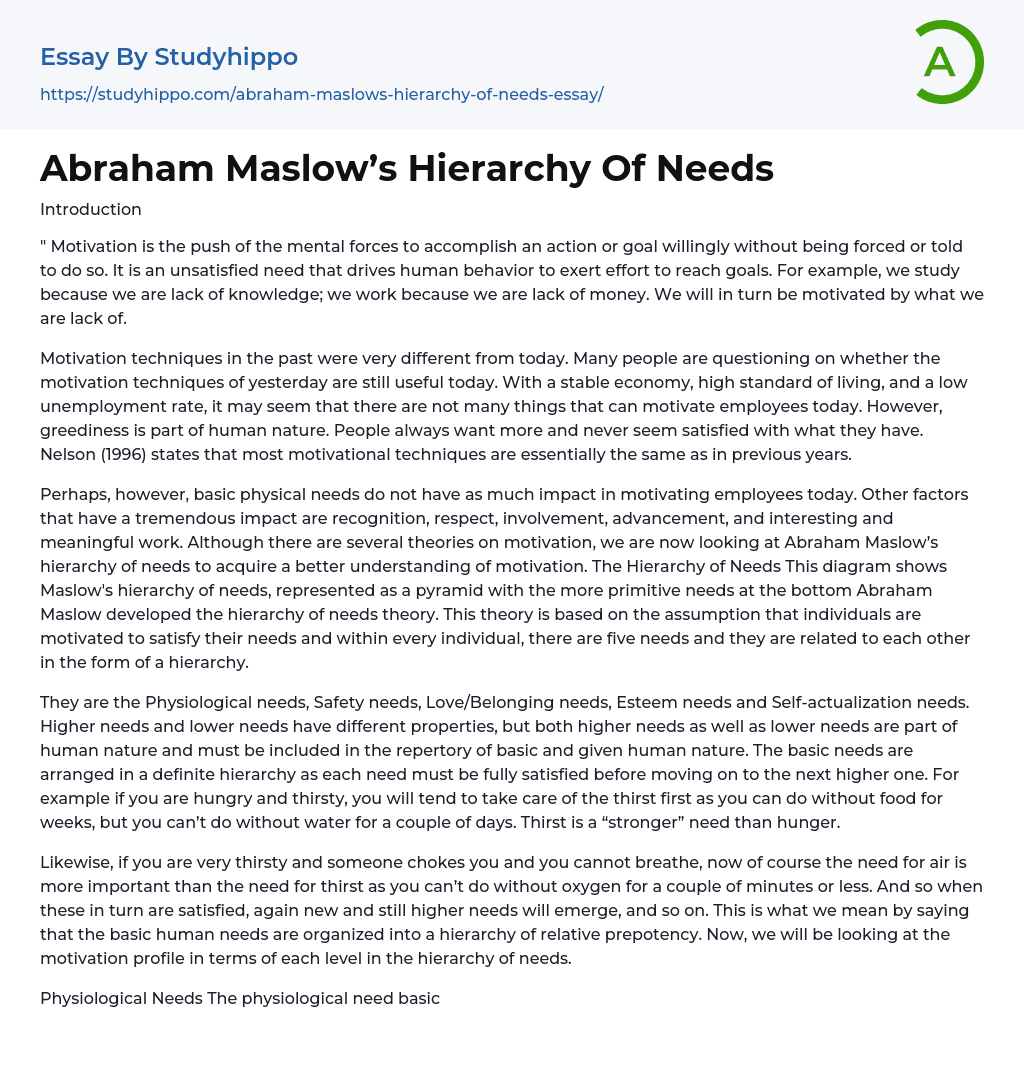Introduction
"Motivation" refers to the internal driving force that encourages individuals to willingly pursue actions or goals, without external coercion or instruction.
The driving force behind human behavior is an unmet need that compels us to strive towards our goals. For instance, we engage in studying because we lack knowledge, and we work because we lack money. Our motivation is influenced by what we lack. The methods used to motivate individuals in the past differ greatly from those employed today. There is widespread debate on the relevance of past motivation techniques in the present day.
Despite a stable economy, high standard of living, and a low unemployment rate, motivating employees today can be a challenge due to the inherent human nature of greed. People are never fully satisfied with what they have and constantly desire more. According
...to Nelson (1996), most motivational techniques remain unchanged from previous years. However, basic physical needs may not hold as much weight in motivating employees today. Instead, factors such as recognition, respect, involvement, advancement, interesting work, and meaningful work have a significant impact.
Abraham Maslow's hierarchy of needs is a theory of motivation that suggests individuals have five needs that are related to each other in a hierarchical structure. Maslow developed this theory based on the belief that people are driven to satisfy their needs. The five needs in the hierarchy are: Physiological needs, Safety needs, Love/Belonging needs, Esteem needs, and Self-actualization needs. This pyramid diagram illustrates the hierarchy, with the more basic needs at the bottom. Although there are various theories on motivation, we are currently focusing on Maslow's hierarchy of need
to gain a deeper understanding.
The human needs are ranked in a hierarchy of relative importance, with each need requiring full satisfaction before moving on to the next level. For instance, if you experience both hunger and thirst, addressing your thirst takes precedence due to its stronger nature compared to hunger. While surviving without food is possible for weeks, going without water can only last a few days. However, if someone were to restrict your breathing while being extremely thirsty, the need for air becomes more crucial than quenching your thirst. This is because survival without oxygen is only feasible for a couple of minutes or less. Once these needs are met, new and higher needs will emerge, perpetuating the cycle of fulfillment.
In the hierarchy of needs, we will examine the motivation profile at each level. The first level consists of physiological needs. These needs involve basic bodily necessities for survival, including oxygen, water, food, sleep, excretion, sex, and essential nutrients like protein and minerals. When a person feels hunger, thirst, or imbalances in their body chemistry, their attention turns towards meeting these deficiencies. Consequently, other needs become less important. If certain needs go unmet, an individual's physiological needs become the primary focus.
Physiological needs can dictate thoughts and actions, leading to feelings of sickness, pain, and discomfort when unmet. There is a growing desire for secure environments, stability, and protection. Additionally, a need for structure, order, and boundaries may arise. Love and belongingness needs emerge when physiological and safety needs are reasonably fulfilled.
The need for love encompasses both giving and receiving affection, leading to a desire for various relationships like friendships, romantic partners, children, family members,
and close connections within a community. When these needs are unmet, individuals strongly yearn for connections with others and actively strive to achieve this. It is crucial for humans to experience a sense of belonging and acceptance, whether in larger social groups (such as religious organizations, professional associations, sports teams, or even gangs) or smaller social bonds (like family members, close colleagues or confidantes). Devoid of these aspects, one becomes more vulnerable to feelings of loneliness and social anxieties.
The priority of love and belonging may sometimes surpass physiological and security needs, influenced by peer pressure. Esteem Needs are universally desired, representing the yearning to be valued and respected from both oneself and others. Engaging in activities that foster contribution, recognition, acceptance, and self-worth fulfills these needs. Esteem needs encompass factors like self-respect, recognition, autonomy, and achievement.
Recognition and status are external factors that impact an individual's self-esteem; nevertheless, gaining respect from others necessitates possessing self-respect as well, a quality that is difficult to diminish. Individuals with low self-esteem and feelings of inferiority cannot rely solely on external achievements such as fame, glory, and respect in order to improve their self-perception; instead, they must cultivate inner acceptance.
Psychological imbalances, like depression, can hinder both levels of self-esteem. In Maslow's hierarchy of needs, the final level called self-actualization stands out as it encompasses growth motivation, being needs, and self-actualization.
- Self Assessment essays
- Self Evaluation essays
- Immigration Reform essays
- Abnormal Psychology essays
- Abraham Maslow essays
- Attachment Theory essays
- Authority essays
- Behaviorism essays
- Classical Conditioning essays
- Cognitive Psychology essays
- Counseling essays
- Developmental Psychology essays
- Educational Psychology essays
- Erik Erikson essays
- Family Therapy essays
- Jean Piaget essays
- Maslow's Hierarchy Of Needs essays
- Mental Health essays
- Operant Conditioning essays
- Personality Psychology essays
- Positive Psychology essays
- Psychoanalysis essays
- Psychotherapy essays
- Sigmund Freud essays
- Social Psychology essays
- Stanford Prison Experiment essays
- Supersize Me essays
- Attitude essays
- Goals essays
- Personal Goals essays
- Personal Life essays
- Personality essays
- Principles essays
- Reputation essays
- Self Awareness essays
- Self Esteem essays
- Self Reflection essays
- Self Reliance essays
- Strengths essays
- Value essays
- Values essays
- Weakness essays
- Who Am I essays




